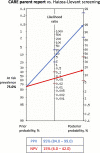Agreement and Reliability of Parental Reports and Direct Screening of Developmental Outcomes in Toddlers at Risk
- PMID: 34650483
- PMCID: PMC8505716
- DOI: 10.3389/fpsyg.2021.725146
Agreement and Reliability of Parental Reports and Direct Screening of Developmental Outcomes in Toddlers at Risk
Abstract
Developmental screening is a practice that directly benefits vulnerable and low-income families and children when it is regular and frequently applied. A developmental screening tool administered by parents called CARE is tested. CARE contains a compilation of activities to report and enhance development at home. Hundred and fifty-seven families in Bogotá (Colombia) initially responded to a call to participate in developmental screening tools' validation and reliability study. All children (Average: 42.7 months old; SD: 9.4; Min: 24, Max: 58) were screened directly by trained applicants using a Spanish version of the Denver Developmental Screening test [i.e., the Haizea-Llevant (HLL) screening table]. After a first screening, 61 dyads were positive for follow-up and received a second HLL screening. Fifty-two out of 61 dyads use and returned CARE booklet after 1-month screening at home. The comparative analysis for parent reports using CARE and direct screening observation included (a) the effects of demographic variables on overall and agreement, (b) agreement and congruence between the CARE report classification and direct screening classification ("At risk" or "Not at risk"), (c) receiver operating characteristic analysis, (d) item-Level agreement for specific developmental domains, and (e) acceptability and feasibility analysis. Results and conclusions show the parental report using the CARE booklet as a reliable screening tool that has the potential to activate alerts for an early cognitive delay that reassure clinicians and families to further specialized and controlled developmental evaluations and act as a screen for the presence of such delay in four developmental dimensions.
Keywords: children at risk; developmental screening; low-middle income countries; parental reports; receiver operating characteristic (ROC) analysis; reliability and agreement studies.
Copyright © 2021 Giraldo-Huertas and Schafer.
Conflict of interest statement
The authors declare that the research was conducted in the absence of any commercial or financial relationships that could be construed as a potential conflict of interest.
Figures





Similar articles
-
Parental developmental screening with CARE: A pilot hybrid assessment and intervention with vulnerable families in Colombia.PLoS One. 2023 Jun 28;18(6):e0287186. doi: 10.1371/journal.pone.0287186. eCollection 2023. PLoS One. 2023. PMID: 37379320 Free PMC article. Clinical Trial.
-
A modified screening tool for autism (Checklist for Autism in Toddlers [CHAT-23]) for Chinese children.Pediatrics. 2004 Aug;114(2):e166-76. doi: 10.1542/peds.114.2.e166. Pediatrics. 2004. PMID: 15286253
-
Parent's Evaluation of Developmental Status (PEDS) detects developmental problems compared to Denver II.J Med Assoc Thai. 2005 Nov;88 Suppl 3:S188-92. J Med Assoc Thai. 2005. PMID: 16862679
-
Parent-mediated interventions for promoting communication and language development in young children with Down syndrome.Cochrane Database Syst Rev. 2018 Oct 15;10(10):CD012089. doi: 10.1002/14651858.CD012089.pub2. Cochrane Database Syst Rev. 2018. PMID: 30321454 Free PMC article. Review.
-
Screening Instruments for Developmental and Behavioral Concerns in Pediatric Hispanic Populations in the United States: A Systematic Literature Review.J Dev Behav Pediatr. 2020 Jan;41(1):71-80. doi: 10.1097/DBP.0000000000000724. J Dev Behav Pediatr. 2020. PMID: 31609290
Cited by
-
Parental developmental screening with CARE: A pilot hybrid assessment and intervention with vulnerable families in Colombia.PLoS One. 2023 Jun 28;18(6):e0287186. doi: 10.1371/journal.pone.0287186. eCollection 2023. PLoS One. 2023. PMID: 37379320 Free PMC article. Clinical Trial.
References
-
- Alcantud F., Alonso Y., Rico D. (2015). Validez y fiabilidad del Sistema de Deteccioìn Precoz de los Trastornos del Desarrollo: 3 a 36 meses [Validity and reliability of the early detection system for developmental disorders: 3 to 36 months-old]. Revista Espanϸola de Discapacidad 3 107–121. 10.5569/2340-5104.03.01.06 - DOI
LinkOut - more resources
Full Text Sources
Miscellaneous

